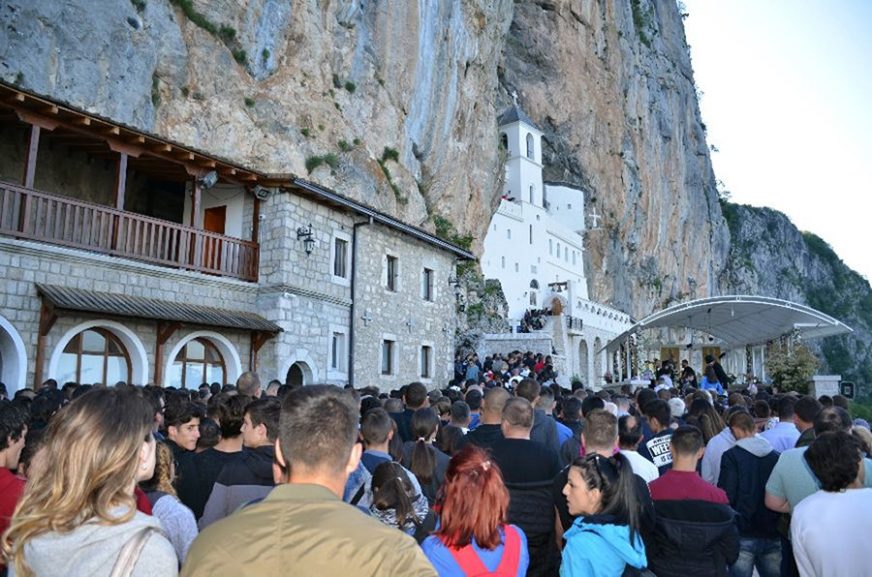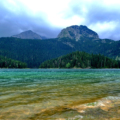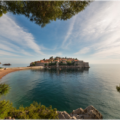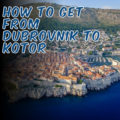Montenegro’s religious backdrop is a tapestry woven with diverse threads of faith. Nestled within its picturesque landscapes, you’ll find a harmonious blend of Orthodox Christianity, Islam, and Catholicism, each contributing to the cultural mosaic of the country. This interplay of religious traditions has left an indelible mark on Montenegro’s history, architecture, and way of life, making it a captivating destination for those intrigued by the intersections of spirituality and culture.
Montenegro offers more than just its stunning landscapes; it holds a treasury of spiritual and historical heritage. The abundance of churches is truly remarkable when pondered upon. Join us on an exploration of the ten most esteemed monasteries and churches, each serving as guardians of Montenegro’s remarkable history and vibrant culture.
Ostrog Monastery
Once, nestled high in Montenegro’s cliffs, Ostrog Monastery whispered tales of 17th-century devotion. Built by Bishop Basil, it became an Eastern Orthodox pilgrimage magnet. Glowing white against rugged black rock, it’s as though the monastery defies gravity.

Have you heard of miracles? Many pilgrims, seeking health and hope, flock to Ostrog. They’re drawn by tales of miraculous healing powers. Legend has it that praying by the relics of St. Basil can cure ailments. Some even sleep on the monastery grounds, believing in the magic of the land. With moonlight painting its walls and a gentle breeze carrying stories of old, Ostrog feels otherworldly.
Today, Ostrog Monastery thrives. It’s not just a relic of the past but a beacon of faith. Thousands annually trek up the steep paths, some barefooted. Whether you’re seeking spiritual awakening or architectural marvel, Ostrog promises awe. In this modern world, it stands as a testament to timeless devotion and wonder.
Cetinje Monastery
In the scenic town of Cetinje, Montenegro’s old royal capital, lies a spiritual treasure. The Cetinje Monastery, established in the 15th century, stands tall, echoing tales of faith, politics, and resilience. Built by Ivan Crnojević, its stone walls have witnessed centuries of Montenegrin history.
But here’s a twist: the original monastery? It’s not the one standing today. Ottoman invasions laid waste to it, but the stories persisted. Tales tell of a printing house inside these walls, producing some of the earliest books in the region. And there’s the mystery of the Cetinje Chronicle, a manuscript detailing Montenegro’s past, rumored to be kept safe within the monastery’s confines.

The Cetinje Monastery today is more than just a historical site. It remains a thriving spiritual center. Pilgrims and tourists alike walk its hallowed halls, often drawn to relics like the right hand of John the Baptist. As Montenegro grows and modernizes, the Cetinje Monastery remains, bridging the past with the present, and inviting all to uncover its secrets.
Our Lady of the Rocks Church, Perast
Picture this: an islet floating in the Bay of Kotor, Montenegro, crowned with a majestic church. That’s Our Lady of the Rocks Church in Perast. But it wasn’t always there. Local lore says seafarers dropped rocks at the spot after every voyage. Over time, an islet emerged, and in the 15th century, the church was born.

Two fishermen kickstarted its legend. On a serene July day, they discovered an icon of the Virgin Mary and Christ on a rocky crag. Inspired, they pledged to create an islet right there. Each year, on July 22nd, locals maintain this pledge. They sail and drop stones around the church in a lively event called “Fasinada”.
Fast-forward to now: Our Lady of the Rocks is a living postcard. Visitors are captivated by its ornate interiors and exquisite paintings by Tripo Kokolja, a famed Baroque artist. While the church stands as a symbol of devotion, the islet reminds us of human tenacity and community spirit. It’s not just a place of worship; it’s a testament to collective dreams and shared stories.
St. Tryphon’s Cathedral, Kotor
St. Tryphon’s Cathedral, consecrated in 1166, is the crown jewel of Kotor’s Old Town and one of the finest examples of Romanesque architecture on the Adriatic coast. Dedicated to the city’s patron saint, the cathedral has weathered centuries of earthquakes, each time rebuilt and restored, giving it its unique blend of Romanesque and later Baroque features. From the square, its twin towers dominate the skyline, framing a façade that instantly draws visitors’ eyes. Inside, travelers discover a trove of medieval frescoes, gilded altars, and a rich treasury of relics connected to St. Tryphon himself.
As you step through its heavy doors, the cool stone interior offers both respite from the Montenegrin sun and a tangible sense of history. Today, as part of UNESCO’s World Heritage–listed Kotor, the cathedral is more than a place of worship—it’s a living testament to the city’s resilience, culture, and devotion, making it an essential stop on any journey through Montenegro.
Savina Monastery, Herceg Novi
Tucked away amidst the lush greens overlooking the Bay of Kotor, Savina Monastery in Herceg Novi is a quiet symphony of history and devotion. Established in the 11th century, its origins are shrouded in tales and traditions. Overlooking azure waters, its domes and walls echo the chants of monks and tales of yore.

While the monastery itself is a testament to Orthodox architectural grandeur, it’s the legend that intrigues many. Whispered stories speak of Saint Sava, the Serbian medieval luminary, who, during his voyages, found solace here and blessed the ground. Thus, the monastery earned its name and spiritual significance. But that’s not all; delve deeper, and you find the Grape Gospel, an ancient manuscript written in wine, housed within these walls.
Today, the allure of Savina Monastery is undeniable. A blend of serene surroundings, ancient structures, and the Church of the Assumption with its impressive frescoes, it’s a spiritual haven. Travelers and pilgrims find their way here, seeking both the tranquility it offers and the layers of history it enfolds. As the sun casts golden hues on its facade and the bay reflects its silhouette, Savina stands, bridging Herceg Novi’s past with the present.
Podgorica Cathedral
Amidst Podgorica’s evolving skyline, a beacon of faith rises, modern yet deeply rooted in tradition. It’s the Cathedral of the Resurrection of Christ. Unlike ancient churches, this cathedral’s story began in the 1990s. With sharp lines, impressive domes, and intricate frescoes, it’s an architectural gem amidst Montenegro’s capital.
What makes it intriguing isn’t just its beauty, but its symbolism. Podgorica, formerly Titograd, bore the scars of war and atheistic policies. So, the cathedral stands as a defiance, a testament to Montenegro’s resilient Orthodox Christian spirit. Inside, you won’t just find typical church artifacts. There’s a unique fresco showcasing Tito, Karl Marx, and Friedrich Engels – not in reverence, but as souls in torment, illustrating the nation’s complex past.
St. Nicholas Church, Kotor
Guarding Kotor’s old town like an ageless sentinel, St. Nicholas Church commands respect. Dating back to the early 20th century, it might seem like a newbie compared to its medieval neighbors, but its stature is undeniable. Its soaring bell tower, the tallest in town, serves as a landmark for sailors and travelers alike.
Legends often weave tales around structures, and St. Nicholas is no exception. Named after the patron saint of sailors, it’s said to embody the town’s connection with the sea. Wander inside, and you’d stumble upon a rich trove of maritime emblems, echoing tales of brave seafarers, treacherous storms, and divine protection.

Today, as the sun sets, casting golden hues on Kotor’s cobbled streets, the church stands proud, blending seamlessly with the town’s ancient charm. Amidst the bustling cafes and historical relics, St. Nicholas offers a space of quiet reflection. It serves as a bridge between Kotor’s rich maritime legacy and its vibrant, ever-evolving present. As the bell tolls, it’s a call to both history buffs and wandering souls, beckoning them to discover Kotor’s deep-rooted bond with the sea.
Dajbabe Monastery
In the outskirts of Podgorica lies a marvel not just built on the land, but within it. The Dajbabe Monastery, a subterranean surprise, dates back to the late 19th century. This sacred enclave, carved within a natural cave, speaks of divine inspiration and monastic solitude.

The story goes that Sveti Simeon Dajbabski, its founder, was guided by a divine vision. Dreaming of a cross on a hill, he discovered the Dajbabe site. Inside the cave, nature’s wonders intertwined with human craft. Over the years, a complex of churches emerged, their walls adorned with frescoes echoing Biblical tales. And here’s a touch of mystery: some say the caves hide even older remnants, possibly dating back to ancient Illyrians.
Reževići Monastery
Perched above the Adriatic’s shimmering blue waters, the Reževići Monastery has been a silent witness to Montenegro’s history since the 13th century. Just outside Petrovac, this secluded haven blends nature, legend, and devotion into a story that continues to captivate all who visit.
Local folklore traces its origin to three noble brothers who, while hunting, stumbled upon a miraculous vision: three roses of different colors blooming side by side. Interpreting this as a divine sign, they set aside their weapons and built three churches on the very spot, their foundations forever tied to faith and myth.
Though centuries of invasions and earthquakes have left their mark, the monastery endures. The Church of the Dormition remains its centerpiece, adorned with frescoes that whisper fragments of medieval life and devotion. Today, pilgrims and travelers alike are drawn not only to its spiritual significance but also to the serenity of its setting—pine-scented air, sweeping views of the Adriatic, and the gentle rhythm of waves below. Reževići is more than a historical monument; it is a living bridge between Montenegro’s legendary past and its timeless present.
St. Michael Archangel Church, Herceg Novi
Dominating Herceg Novi’s Belavista Square, St. Michael Archangel Church stands as an emblem of faith and history. This Baroque beauty, with roots tracing back to the 19th century, is more than just stone and mortar; it’s the soul of the town, bearing witness to countless seasons of change.
Stories whisper of its intricate iconostasis, a gift from Russia’s last Tsar, Nicholas II. Crafted by skilled artisans, it’s a testament to the age-old ties between Montenegro and Russia. But there’s more than just gifts from distant lands. Legends also speak of hidden treasures and relics, safeguarded within its walls, each with tales waiting to be told.
Now, amidst the bustling vibes of modern Herceg Novi, the church remains a sanctuary of serenity. As the sun’s rays dance upon its façade, and the bells chime melodiously, St. Michael Archangel Church invites all. Whether to seek solace, marvel at artistry, or simply to touch a piece of Herceg Novi’s heartbeat, the church doors are always open, echoing with tales of yesteryears and dreams of tomorrow.
Across Montenegro, historic buildings tell tales of faith and time. From caves to coastlines, each site has its unique story. These places, both ancient and awe-inspiring, connect the past with today. They are more than just stone; they’re the heart and soul of the nation. As we explore, we’re invited not just to see, but to feel Montenegro’s deep-rooted spirit. From bell chimes to sunset views, these landmarks stand as silent, yet powerful, reminders of a rich heritage.







